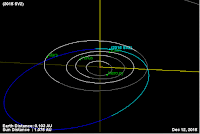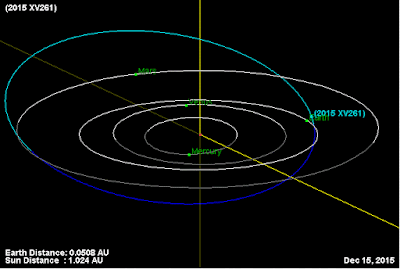Asteroid
2015 XV261 passed by the Earth at a distance of 2 609 000 km (6.78
times the average distance between the Earth and the Moon, or 1.75% of
the average distance between the Earth and the Sun),
slightly after 3.05 am GMT on Tuesday 8 December 2015. There was no danger
of the asteroid
hitting us, though had it done so it would have presented only a minor
threat. 2015 XV261 has an estimated equivalent diameter of 16-49 m (i.e.
it is estimated that a spherical object with the same volume would be 16-49 m in diameter), and an object of this size would be expected to
explode in an airburst (an explosion caused by superheating from
friction with the Earth's atmosphere, which is greater than that caused
by simply falling, due to the orbital momentum of the asteroid) in the
atmosphere between 25 and 9 km above the ground, with only fragmentary
material reaching the Earth's surface.
The calculated orbit of 2015 XV261. JPL Small Body Database.
2015 XV261 was discovered on 11 December 2015 (three days after its closest approach to the Earth) by the University of Arizona's Catalina Sky Survey,
which is located in the Catalina Mountains north of Tucson. The
designation 2015 XV261 implies that it was the 6546th asteroid (asteroid V261)
discovered in the first half of December 2015 (period 2015 X).
2015 XV261 has a 553 day orbital period and an eccentric orbit tilted at an
angle of 17.9° to the plane of the Solar System that takes it from 0.92
AU from the Sun (i.e. 92% of the average distance at which the Earth
orbits the Sun) to 1.71 AU from the Sun (i.e. 171% of the average
distance at which the Earth orbits the Sun, more than
the distance at which the planet Mars orbits). It is therefore classed
as an
Apollo Group Asteroid (an asteroid that is on average further from the
Sun than the Earth, but which does get closer). This means that close
encounters between the asteroid and Earth are fairly common, with the
last thought to have happened in July this year and the next predicted in June 2018.
See also...
 Asteroid 2015 SV2 passes the Earth. Asteroid 2015 SV2 passed by the Earth at a distance of 14 800 000 km (38.5 times
the average distance between the Earth and the Moon, or 9.89% of the
average distance between the Earth and the Sun), at about 3.45 pm
GMT on Saturday 5 December...
Asteroid 2015 SV2 passes the Earth. Asteroid 2015 SV2 passed by the Earth at a distance of 14 800 000 km (38.5 times
the average distance between the Earth and the Moon, or 9.89% of the
average distance between the Earth and the Sun), at about 3.45 pm
GMT on Saturday 5 December... Asteroid 2015 WB13 passes the Earth. Asteroid
2015 WB13 passed by the Earth at a distance of 18 950 000 km (49.3 times
the average distance between the Earth and the Moon, or 12.7% of the
average distance between the Earth and the Sun), at about 8.55 pm
GMT on Thursday 3...
Asteroid 2015 WB13 passes the Earth. Asteroid
2015 WB13 passed by the Earth at a distance of 18 950 000 km (49.3 times
the average distance between the Earth and the Moon, or 12.7% of the
average distance between the Earth and the Sun), at about 8.55 pm
GMT on Thursday 3... Geminid Meteor Shower should be clearly visible this year.
The Geminid Meteor Shower is expected to peak on Sunday 13-Monday 14
December this
year (2015) with potentially up to 120 meteors per hour being visible in
areas of the Northern Hemisphere with a clear sky...
Geminid Meteor Shower should be clearly visible this year.
The Geminid Meteor Shower is expected to peak on Sunday 13-Monday 14
December this
year (2015) with potentially up to 120 meteors per hour being visible in
areas of the Northern Hemisphere with a clear sky...
Follow Sciency Thoughts on Facebook.

